Forests and Rangelands Success Story
San Pascual and Ladrone Prescribed Burn - Hazardous Fuels Projects
Socorro Field Office, Bureau of Land Management (BLM), New Mexico
National Fire Plan - Fuels Reduction
2008
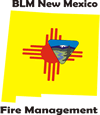
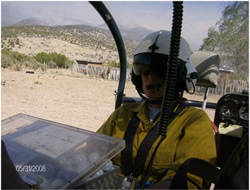
Plastic sphere dispenser (PSD) Operator Bethany Ritter (BLM Socorro Range Specialist) ready to takeoff for the Ladrone Prescribed Burn.
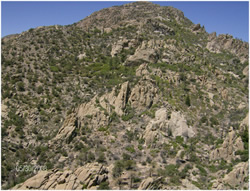
Typical fuels and topography on Ladrone Mountain.
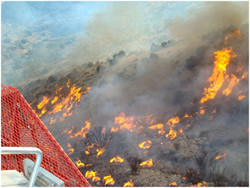
Typical fire behaviors on the Ladrone Prescribed Burn.
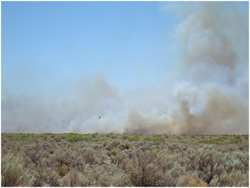
PSD operations on the San Pascual Prescribed Burn.
The Socorro Field Office has been working on a multiyear-multiphase hazardous fuels and forest health project since 2000, in the San Pascual and Ladrone Mountain areas. They are located within Socorro County and collaboration for these projects occurred with the U.S. Fish and Wildlife Service (FWS), New Mexico Game and Fish (Sikes Act) and the New Mexico State Land Office. A late-season snowstorm put a halt to a 38,000-acre landscape level burn, but having two projects "on-the-shelf" allowed us to adjust to changing weather and fuel conditions in different parts of the field office.
In the San Pascual burn, the main benefits were to reduce woody species encroachment into grasslands (especially sage), improve forage for wildlife, and restore the natural role of fire into the ecosystem. The first phase of burning took place on March 6, 2008, mostly black lining, and hand ignition, which included one day of interior ignition with a helicopter and plastic sphere dispenser (PSD). The second phase of burning started on May 28, 2008, which included one day of interior aerial ignition with PSD, with some perimeter ignition by hand and ATV torch. The second phase included locations on the east side of Bosque del Apache National Wildlife Refuge (NWR). The White Sands Missile Range lands were included as part of the allowable burn area (east side of the burn). The BLM portion of the burn is entirely within the Antelope Wilderness Study Area (WSA) (bordered by roads). The FWS portion mostly is within the Little San Pascual Wilderness. In May, the FWS monitored the burn for the next couple of days so we could move to the Ladrone prescribed burn. Acreage burned totaled 11,222 acres on FWS land, 3,058 acres on BLM land, 331 acres on private land, and 144 acres on state land. This project was completed in May, but maintenance burns will be conducted every 10 to 20 years.
The Ladrone burn targeted benefiting factors that enhanced desert bighorn sheep habitat by reducing predator hiding cover and improving forage and browse, rejuvenating browse and forage for wildlife, maintaining and enhancing ponderosa pine stands, and reducing pinyon-juniper (PJ) encroachment. The vicinity of the burn was located mostly in the Sierra Ladrones Wilderness Study Area (WSA), which was extremely rugged with little vehicle access. The burn area was highly visible from I-25 and the communities of Belen and Socorro. Over 2,000 acres were thinned in 2000, with an additional 900 acres thinned in 2003 to 2004 (all outside the WSA). Portions were burned in the past with varying success due to broken rocky terrain and discontinuous fuels including 2,500 acres minimally successful in 2003, 787 acres of old thinning slash in 2005, and 149 acres of old thinning slash in 2006. The FWS provided good cooperation by providing key burn personnel (i.e. helicopter manager and firing boss). A small part of the Sevilleta National Wildlife Refuge (64 acres) and private land (41 acres) was also burned. Bethany Ritter, Range Specialist for the Socorro Field Office, was the plastic sphere dispenser (PSD) operator for the four days during burning. She spent five days riding backwards in the helicopter and dropped over 120,000 balls. This project is on going and will be completed in phases, with follow-up maintenance treatments.
Both of these burns were completed over a four-day period in May. The Socorro Field Office continues to work well with their interagency partners to implement projects across ownership boundaries.
Contact: Lann Moore, Fuels Specialist, Albuquerque District Office (575) 838-1296.